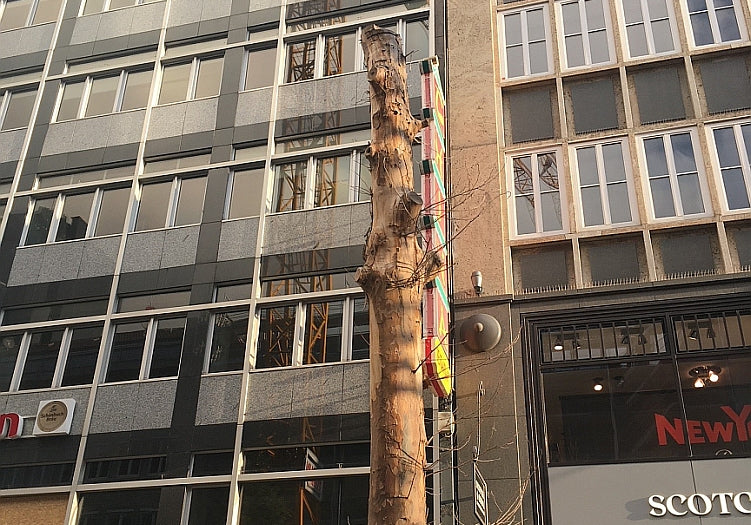Your shopping cart is currently empty.
| Subtotal | €0,00 |
| Shipping Rate | including VAT, excl. Shipping Rate |
| Total | €0,00 |
|---|
14.11.2023
Read article
When did you first hear about drought stress in trees? For me it was autumn 2020. And since then I've heard the word drought stress again and again - and more and more frequently. Perhaps drought stress has become a new normal. Since 2018 at least, the trees seem to have hardly experienced a summer that hasn't challenged them with heat and drought. It is time to deal more intensively with the topic of drought stress in trees.
What is drought stress?
Drought stress is a stress condition caused by lack of water. Water is a vital elixir for trees, needed for almost all biochemical reactions. If there is a lack of water, they become ill or die. For example, trees with a lack of water can no longer defend themselves efficiently against pests such as fungi or bark beetles. Drought stress therefore makes trees susceptible to disease. In this Post you can find more information about it.
If the trees lack water, the first reaction is to close their stomata, the small stomata, and thus no longer be able to carry out photosynthesis. If they did not close them, more water would evaporate from these small openings and the tree could dry out. However, without the sugar produced by photosynthesis, the trees lack the building material for growth, fruit and seeds.
If this immediate measure does not help enough, trees have other strategies. Some tree species can reduce solar radiation by drooping or curling their leaves. Other tree species start moving their leaves, such as the aspen. With even more severe water shortages, some trees will also begin to shed leaves. And some trees, such as oaks, poplars and willows, also shed whole branches.
If the lack of water lasts for a longer period of time, entire parts of the tree can eventually die. The tree prefers to sacrifice some parts in order to be able to continue living. If the tree can no longer save itself through this, it will dry out.
Which trees are affected?
In principle, all trees can suffer from drought stress in the hot summer months, including trees in forests. In most cases, however, trees in towns and villages as well as on orchards are much more affected by drought stress. In forests, trees cool each other's air, and the forest floor is covered with organic matter, making it much more sheltered than urban soil. In cities, on the other hand, there are higher average temperatures, additional pollution and compacted soils. The more urban a tree's environment is, the more susceptible it is to drought stress.

Another important factor is the type of tree, because each has its own climatic comfort zone. Some tree species cope better with drought stress than others. Here you can find an article about City trees of the future.
Young trees are particularly susceptible to drought stress. Their roots are not yet strong enough to penetrate the deeper soil layers to draw water. Young trees in particular should be watered in dry and hot weather.
Here is an overview of the most important signs of drought stress:
- Dried, drooping, curled, or folded leaves
- leaf wagging or trembling
- shedding of leaves
- shedding of branches
- Formation of significantly smaller leaves
- Formation of excessively many and small fruits
- When trees are watered, there is often an immediate recovery
If a dry period lasts up to four weeks, most trees can still handle it reasonably well. A dry period of two to three months, on the other hand, is already critical for many trees. The more often dry periods occur in a growing season, the more difficult it becomes for the trees. They then lack the time in which they can regenerate.
What to do against drought stress?
The most important and most efficient remedy against drought stress is tree-friendly watering. The most important rule is: a lot of water at once, but not too often. In dry and hot weather, trees should be watered 2-3 times a week with 150-200 liters of water. It is also important that the water is not released too quickly. If water is released too quickly, a large part of it runs off the surface without being able to seep into the deeper root areas.
This is why there are tree watering bags. The bags are placed around the trunk, sealed and then filled with 75 to 100 liters of water, depending on their size. Through small holes on the ground, the water is released to the earth drop by drop between 6 and 9 hours. Through this Drip irrigation the soil in the root area of the tree has enough time to absorb and store the water. Multiple bags can also be connected together, allowing 150 liters of water to be dispensed in one go.

In addition to tree-friendly watering, you can also care for the root area of the tree in such a way that it can absorb and store the water well. The following measures can help:
- Plant accompanying greenery: Other plants in the root area root through the soil and ensure that the water can seep away better.
- Mulching: A layer of mulch ensures that the soil can store moisture better and stay soft for longer. A soft soil can absorb and store water better.
Prevention is the easiest and cheapest
It is best to give trees general watering during prolonged heat and drought. In this way, the trees can continue to carry out photosynthesis and actively defend themselves against diseases and pests. The trees should be watered at the latest at the first signs of drought stress. Especially if you want to harvest plenty of fruit and nuts, you should also make sure that the trees have enough water in spring.
Here is a text about them increasing problems of urban trees.
Summary of drought stress in trees:
Trees suffering from drought stress show various signs and can develop significant health problems. Drought stress occurs when trees do not receive sufficient water to meet their physiological needs. Here are some signs and effects of drought stress in trees:
- Leaf discoloration and fall: An early sign of drought stress is leaf discoloration. They may turn yellow, develop brownish edges, or fall off prematurely.
- Wilting and drying out: Trees under drought stress often show signs of wilting, particularly of leaves, needles or twigs. The leaves can dry out and lose their elasticity.
- Reduced growth: Drought stress can affect the growth of trees. The formation of new shoots and leaves may be reduced, and the overall development of the tree may be inhibited.
- Cracked bark: If drought stress lasts for a long time, the bark of the trees can develop cracks. This happens because the tree removes water from cells to maintain vital functions.
- Lower fruit production: Trees may produce fewer fruits under drought stress because water is necessary for flower and fruit formation.
- Susceptibility to diseases and pests: Drought stress makes trees more susceptible to diseases and pests. Weakened trees often have difficulty resisting pathogens and insect attacks.
- Reduced photosynthesis: Drought stress affects the ability of trees to photosynthesize. This process by which plants convert light energy into chemical energy is essential for their growth and energy production.
- Changes in metabolism: Under drought stress, trees can adapt their metabolism to conserve water. This can lead to changes in the production of chemical compounds important for normal growth.
- Increased susceptibility to extreme temperatures: Drought stress can make trees more sensitive to extreme temperatures, be it cold or heat.
- Root loss and soil changes: Drought stress often causes trees to lose some of their roots. This not only affects water absorption, but can also stabilize the soil and contribute to erosion.
Measures to mitigate drought stress in trees may include providing adequate irrigation, adjusting tree care practices, mulching, selecting drought-resistant tree species, and minimizing soil compaction. It is important to understand trees' water needs and provide supplemental irrigation during dry periods to maintain their health and vitality.
Do you want more tree knowledge?
That might interest you
Great idea, easy handling and everything from ordering to delivery.
Michael K.
















